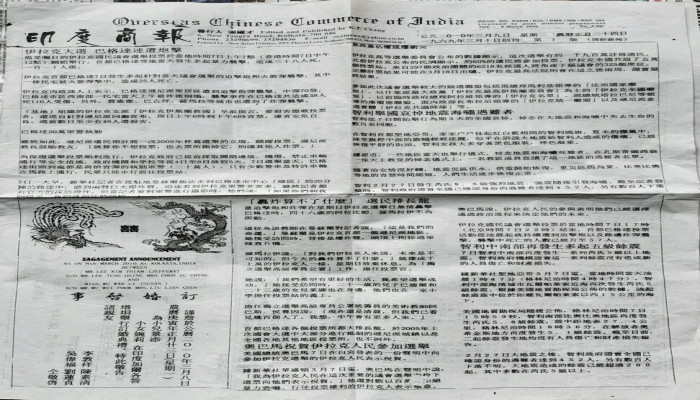India's 'only' Chinese newspaper bids adieu
- In Reports
- 11:49 AM, May 24, 2023
- Myind Staff
The Overseas Chinese Commerce of India or Seong Pow, Kolkata's and may be India's only Mandarin newspaper, may have been lost forever, dealing a sad blow to the city's already quickly declining Chinese minority and its culture.
No one TOI spoke to could be certain of the date, but the most recent edition was printed not long before the pandemic-induced lockdown in March 2020.
Seong Pow, the first Chinese newspaper in India, was launched in 1969 by Lee Youn Chen, a prominent member of the Chinese community. Due to a lack of reporters, Seong Pow, a four-page daily, was used to aggregate and translate news into Mandarin from the top English-language newspapers in China, Taiwan, Hong Kong, and Kolkata.
Back then, the four-page journal was written completely by hand. A team of four or five – including assistants, an accountant, and a translator – published 2,000 copies daily, to cater to Kolkata’s Chinese population. A Chinese desktop publishing machine did away with the need for handwritten pages in 1989 and, in 1997, the newspaper acquired a printing press.
Until March, the paper was running smoothly, even though its subscriber base was dwindling. However, the pandemic hit and, for the first time, Seong Pow’s press stopped. The elderly Kuo-tsai Chang, the newspaper's editor, passed away in July of that same year, putting a final stop to circulation that had been interrupted during the initial wave of the pandemic.
Chen also urged Helen Yang, the late editor's assistant, to create a new batch of recruits for the paper by training them in Mandarin since she used to teach the language to neighborhood kids. The ideas never materialized, possibly in part because the majority of Tangra people are now Hakka Chinese, who place little significance on a Mandarin newspaper due to their ethnic transformation into a majority Hakka society.
Today, the door to the newspaper’s office – within which are two tables, two computers, two landline phones, two cupboards, a few chairs, a printer, and a rack full of brittle old newspapers – is locked shut and the Chinese Tannery Owners’ Association building in which it can be found is deserted.
The history of Chinese settlers in Kolkata goes back to the British colonial era. According to the Indian census, the city was once home to around 30,000 Chinese migrants. When India's Supreme Court mandated that the 230 tanneries in Tangra be relocated in order to lessen pollution in the city, the Chinese minority in Kolkata took a severe hit. Another location, Bantala, which is 25 kilometers (16 miles) outside the city center, was suggested; however, it is still largely vacant, and the majority of the former tannery workers have either moved away or changed careers, with many becoming restaurateurs.
Image source: South China Morning Post







Comments